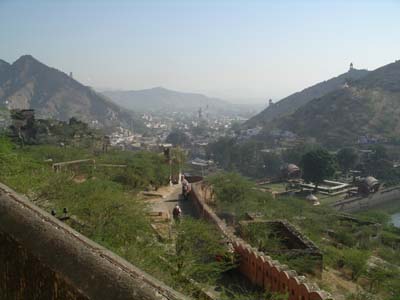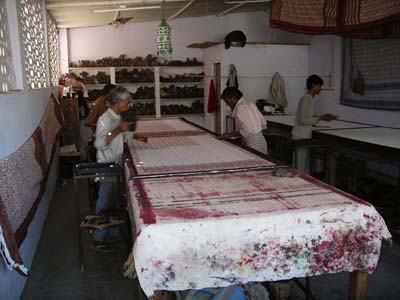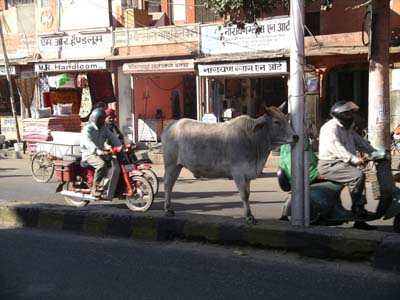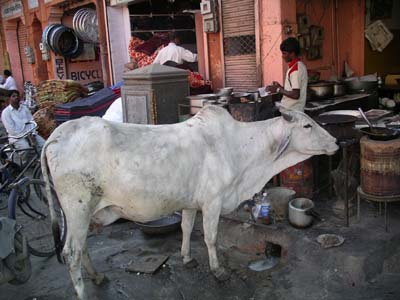Monday, February 16
Steve: Today was our day to explore Jaipur, a city that
we've heard many great things about. From what we saw last night, it appeared
that Jaipur had much of the color and activity of Delhi, but was much easier
to walk and explore. This is largely due to the wider streets (and sidewalks
- kind of…). We also planned to visit several of Jaipur's historical
sites.
We began with a short drive to Amber, which was the capital of Jaipur from
the 10th through the 18th century. Amber is dominated by its fort, which houses
a large and impressive palace. Along with many other Western tourists (the
most we've seen so far), we started with an elephant ride up the hill to the
Amber Fort. This was the first time any of us has been on an elephant, so now we can check it off of our "things to do list"… We had
to laugh at the hawkers who perch themselves on walls and actually try to
sell us things while we're on the elephant!
now we can check it off of our "things to do list"… We had
to laugh at the hawkers who perch themselves on walls and actually try to
sell us things while we're on the elephant!
 The
Amber Fort is very impressive. Built over a period of 200 years, it housed
the Maharaja and his 12 legal wives. Many of the rooms boast very intricate
ceilings with imbedded mirrors, all with original colors. As with many of
the other palaces we've seen, the Amber Fort has a series of water-based cooling
systems. We also saw several of the secret passageways used by the wives that
lived here. One of the things that made this palace and fort impressive is
the 18 kilometer wall which surrounds it and the town. Most of the wall is
positioned on the ridge of a hill which stands well above the fort. As we
looked down from the fort we could
The
Amber Fort is very impressive. Built over a period of 200 years, it housed
the Maharaja and his 12 legal wives. Many of the rooms boast very intricate
ceilings with imbedded mirrors, all with original colors. As with many of
the other palaces we've seen, the Amber Fort has a series of water-based cooling
systems. We also saw several of the secret passageways used by the wives that
lived here. One of the things that made this palace and fort impressive is
the 18 kilometer wall which surrounds it and the town. Most of the wall is
positioned on the ridge of a hill which stands well above the fort. As we
looked down from the fort we could  also
see elephants bathing in the lake below.
also
see elephants bathing in the lake below.
Next we visited the City Palace Complex and Jaipur's nearby observatory in
the heart of the old city. The observatory was built by the Maharaja Jai Singh
in 1728, and houses an amazing series of outside instruments that measure
the position of the sun and stars. It is one of 5  such
observatories that were built throughout India, and is the best preserved.
We especially enjoyed learning about the large sundials here, one of which
is accurate up to 2 seconds.
such
observatories that were built throughout India, and is the best preserved.
We especially enjoyed learning about the large sundials here, one of which
is accurate up to 2 seconds.
Next we went into the City Palace and visited its grounds and museums. The museums house a variety of articles from India's rulers, including clothing, household items, weapons and art. The last King of Rajasthan still resides at the palace - he lost his official power as part of India's independence in 1948, but still retains his title.
 After
a relaxing lunch, we visited some Indian craft shops where we observed the
production of jewelry, textiles and rugs. We had been wary about these places,
largely due to similar experiences in other places (primarily Istanbul) where
the informative demonstrations were followed by very hard sells. Utpal assured
us that he'd help us manage this, and that it would be well worth seeing the
work in action. He was right. We
After
a relaxing lunch, we visited some Indian craft shops where we observed the
production of jewelry, textiles and rugs. We had been wary about these places,
largely due to similar experiences in other places (primarily Istanbul) where
the informative demonstrations were followed by very hard sells. Utpal assured
us that he'd help us manage this, and that it would be well worth seeing the
work in action. He was right. We  greatly
enjoyed watching precious stones being cut and polished, Persian rugs being
woven, cut and cleaned, and cotton cloth being hand printed using carved teak
blocks. We learned that the workers are highly skilled at what they do, and
earn an average of 250
greatly
enjoyed watching precious stones being cut and polished, Persian rugs being
woven, cut and cleaned, and cotton cloth being hand printed using carved teak
blocks. We learned that the workers are highly skilled at what they do, and
earn an average of 250  Rupees
(that's about $6) per day. David and Katie both got opportunities to try their
hand at weaving a rug. We were amazed to learn that it takes 40 days to weave
1 square meter of rug!
Rupees
(that's about $6) per day. David and Katie both got opportunities to try their
hand at weaving a rug. We were amazed to learn that it takes 40 days to weave
1 square meter of rug!

We decided to spend the rest of the afternoon walking through the streets and bazaar in Jaipur. We had a wonderful time just taking in all the color, noise and activity here. There are no such things as crosswalks (or street lights) in Jaipur - pedestrians never have the right of way, and crossing streets was quite an adventure. We enjoyed strolling through the bazaar area, and successfully bought some souvenirs that we had been looking for, including a charm for Katie (she's collecting one from each country) and an Indian sari that she had fun learning how to wear. We tried to take several pictures today to simply capture the exceptional color and life here.





We photographed several of the animals that we saw in the streets here, including pigs, monkeys, cows, and elephants. What a scene!






Everywhere we went, people stopped to speak with us, and no one objected
to having their pictures taken. They also laughed and were excited to see
themselves on our camera as we showed them the images of our pictures. We
took several pictures, trying to capture the color and activity here…
it's hard to do, and the pictures don't really convey the scene - however,
the images will remain strong in our minds.
The extremes of India that Ashok told us about when we first arrived in Delhi were never more apparent than today. Our hotel, the Raj Palace, is luxurious and actually used to be a palace. It's quiet and elegant, and sports a beautiful façade that is set back from one of Jaipur's busiest streets. As we walk out the front door, we're immediately in a totally different world, one which will never know or experience the comfort of something like the Raj Palace. It's literally two different worlds.
As we walked back to our mini-bus, a very funny event occurred. During this morning's elephant ride, several photographers swarmed around us taking pictures telling us that they'd be waiting later with prints of the photos. We never saw the photographers again while we were in Amber. However, a full 6 hours later and in a location about 7 kilometers away, we were approached by a man who was holding 3 large color prints that he had taken of us during our elephant ride! Although we had several pictures that were taken with our own camera, we immediately purchased the photos (for 150 rupees, or $4), primarily to reward the man for his diligence in tracking us down. Unbelievable!
Tomorrow we're leaving Jaipur and driving further west to the small town of Pushkar.
